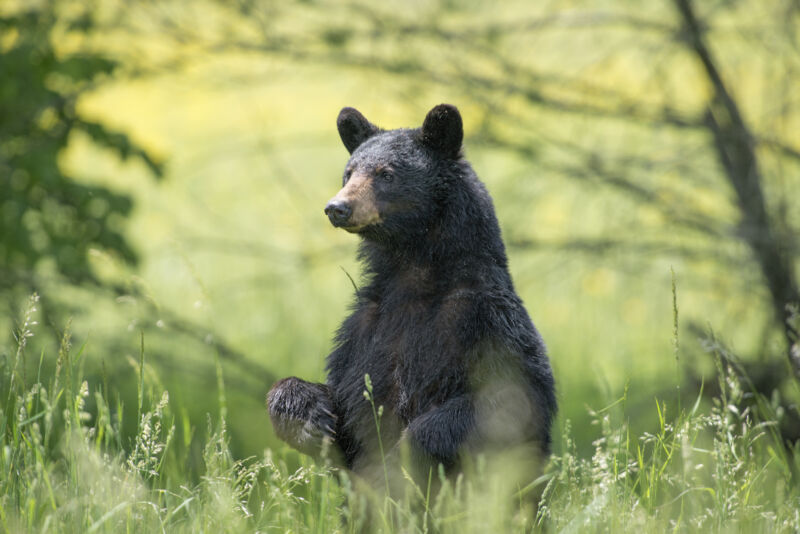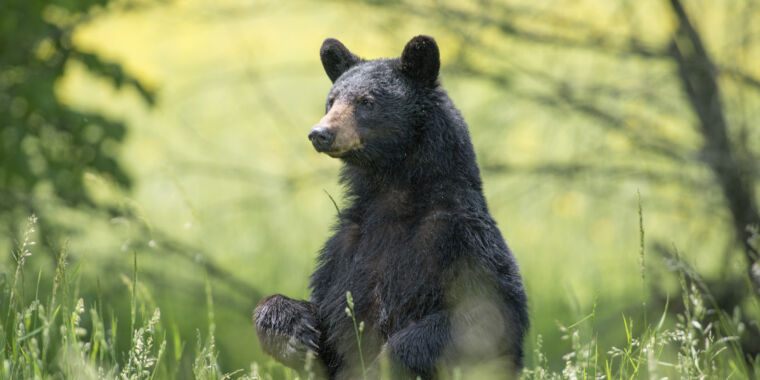Study finds bigfoot sightings correlate with black bear populations

Enlarge / Black bears will frequently stand on their hind legs, which may increase their misidentification.
The idea that North America is home to a completely unknown primate species just doesn’t seem to go away. Years after everyone started walking around with high-quality cameras in their phones, there still haven’t been any clear images of a bigfoot. But that hasn’t stopped a steady flow of purported sightings.
Now, someone named Floe Foxon has followed up on an earlier analysis and checked for factors that could influence the frequency of bigfoot sightings throughout North America. The results suggest that there’s a strong correlation between sightings and the local black bear population—for every 1,000 bears, the frequency of bigfoot sightings goes up by about 4 percent.
Big (foot) data
It’s easy to see how black bears and bigfoot could be mistaken for each other. Despite their name, the bears come in a wide range of colors, from a golden brown through to a deep reddish one, as well as their namesake black. They’re also large animals and will frequently stand on their hind legs to get a better view of their surroundings. They also frequent the forested areas that are supposedly bigfoot’s favored terrain. Foxon even quotes a reported bigfoot sighting as saying that pictures were obtained but, “One of the pictures looks like a bear.”
Earlier work had used data from the Pacific Northwest to show that the presence of bears correlated with the frequency of bigfoot sightings. But Foxon decided to expand the analysis, bringing in the rest of the US and Canada.
The most recent comprehensive, peer-reviewed data on black bear populations dates from 2006, so the analysis was performed using data from that year. Even so, a number of states and provinces had to be excluded. Sadly for Delaware, Hawaii, Illinois, Indiana, Iowa, Kansas, Nebraska, North Dakota and South Dakota, there were no known black bear populations in those states in 2006. And good population numbers weren’t available for Rhode Island, Texas, Wisconsin, Wyoming, Alberta, Newfoundland and Labrador, Northwest Territories, and Nova Scotia. So, while the work is more comprehensive than the Pacific Northwest-only analysis, there were still considerable gaps.
Data for sightings came from the Bigfoot Field Researchers Organization, which maintains a geo-tagged database of reported sightings. National census data was used to determine the human populations in these areas, and estimates of the amount of forested area were also obtained from the Canadian and US governments.
All of these were combined into two different models. In both models, a larger human population was expected to increase the probability of sightings simply due to increased opportunity. Since bigfoot sightings tend to occur in forested areas—and it’s hard to see how a large primate could hide in most other terrains—forests and sightings were also expected to correlate.
Where the bears are
The key difference between the models was whether they included the local black bear population or not. The model with a bear variable provided a much better fit to the data, suggesting that mistaken identity is a factor in bigfoot sightings.
Overall, Foxon found that, with forested areas and the human population taken into account, there’s about one bigfoot sighting for every 5,000 black bears. Each additional 1,000 bears raises the probability of a sighting by about 4 percent. Hence, the conclusion that “if bigfoot is there, it could be a bear.”
That’s not to say bears account for everything. Foxon notes that there are states without a known breeding population of bears that still have bigfoot sightings. And the human population levels could contribute as a source of mistaken identities in addition to raising the opportunity for sightings.
The paper also suggests that this finding could be helpful for bear conservation, as the frequency of bigfoot sightings may provide a proxy measure for the number of black bears present and thus could provide an independent method of tracking population changes.
Journal of Zoology, 2024. DOI: 10.1111/jzo.13148 (About DOIs).
Study finds bigfoot sightings correlate with black bear populations Read More »
